Hydrangeas are a popular flowering shrub that can be grown in full sun. The flowers come in various colors and sizes, so you’ll want to choose the right hydrangea for your garden.
A full-sun location is recommended for hydrangeas because they need plenty of sunlight to grow well. If you don’t give them enough light, they won’t bloom!
However, it’s important to remember that the amount of sunlight required varies depending on the hydrangea you choose.
This article will cover the hydrangea varieties for sun and give tips on how to care for them.
Best Types of Hydrangeas for Sun to Grow

Hydrangeas are one of the most popular types of flowers for many reasons: they’re versatile, long-lasting, and easy to grow.
But if you want to make sure yours will survive summer in full sun, there are some things that you need to know.
Let’s start with what makes a hydrangea suitable for the full sun:
First and foremost, it needs to be a sun-tolerant hydrangea. If you have any doubts about if your particular plant is shade tolerant, there are two ways to find out:
- Check if it has a natural habit of growing under trees or other large plants;
- Look at its leaves—if they’re narrow and pointed, it’s probably more shade tolerant than if they’re rounded and broad.
Next up is water—you’ll want to keep an eye on how much sunlight your new hydrangea gets every day (as well as how much water) because this can affect how quickly it grows.
If it’s getting too little light or water, its leaves may turn brown from chlorosis; if it gets too much light or water, its leaves may turn brown from sunscald. So keep an eye on those leaves!
And lastly, you’ll want to make sure the soil is well-draining and acidic (around 6.5 pH) if you’re growing them in pots—this will help ensure they don’t get root rot.
So what are the hydrangea cultivars for sun?
There are lots of great options for growing hydrangeas for direct sun. These include:
- Hydrangea macrophylla for sun
- Hydrangea paniculata for sun
- Hydrangea arborescens for sun
- Hydrangea quercifolia for sun
1. Hydrangea Macrophylla (Bigleaf Hydrangea)
Hydrangea macrophylla, or the bigleaf hydrangea, is a popular plant because it produces some of the most spectacular blooms in your garden.
The leaves are also relatively large and deep green, so they can be quite striking when paired with the large flowers.
But what makes this type of hydrangea so great? Well, first of all, it’s a small shrub with medium-sized leaves that grow in large bunches around each stem.
The flowers themselves come in many different colors, ranging from pink to purple to white, and even blue hydrangeas for full sun!
So you can definitely find one that will fit your aesthetic (and if you need more time to spend searching through all the varieties available at your local nursery).
This plant tolerates full sun but can also tolerate partial shade during its growing season (between April and October).
It’s not fussy about soil type—it can grow well in sandy and clay soils—so if you live in an area where soil conditions aren’t ideal, this might be a good option for you.
The bigleaf hydrangea is also known for being resistant to pests and disease, making it an excellent choice for anyone who wants to add some color to their landscape without having to deal with issues like aphids or powdery mildew.
The ‘Cityline’ series is the most popular bigleaf hydrangea for sunny areas.
1. Hydrangea Macrophylla ‘Cityline Paris’

The Cityline Paris hydrangea is a popular choice among gardeners who want to add some color to their landscape.
This variety has large, deep green leaves and brilliant red flowers that bloom throughout the summer months.
2. Hydrangea Macrophylla ‘Cityline Venice’

Hydrangea macrophylla ‘Cityline Venice’ is a bright pink variety of hydrangea that will change to green as its flowers age.This plant should be protected over winter; it’s sensitive to certain soil pH levels.
However, its vibrant color adds an elegant touch to the landscape, and it can be used as an accent plant or as the main focal point in your garden.
3. Hydrangea Macrophylla ‘Cityline Mars’

The hydrangea macrophylla ‘Cityline Mars’ is a great choice for full sun. Hydrangeas come in all shapes, sizes, and colors—you can even find varieties with pink or blue blossoms with white borders!
The soil pH of your garden will affect the coloration of these hydrangea blooms: add aluminum for bluer shades; lime to make them redder.
This variety has a particularly long bloom time; this hydrangea will continue to flower throughout the summer and fall months.
4. Hydrangea Macrophylla ‘Cityline Vienna’

Hydrangea Macrophylla ‘Cityline Vienna’ is a hydrangea that grows best in full sun. This plant produces large mophead flowers, and they may be either pink or blue depending on your soil pH level.
Salt tolerance makes ‘Vienna’ an excellent option for roadside planting; however, if you are considering growing it near the coast, make sure to check how high of a tidal zone you live in, as flooding could cause root rot.
But they don’t last long, so you will have to keep pruning them if you want to keep the plant looking good.
5. Hydrangea Macrophylla ‘Cityline Rio’
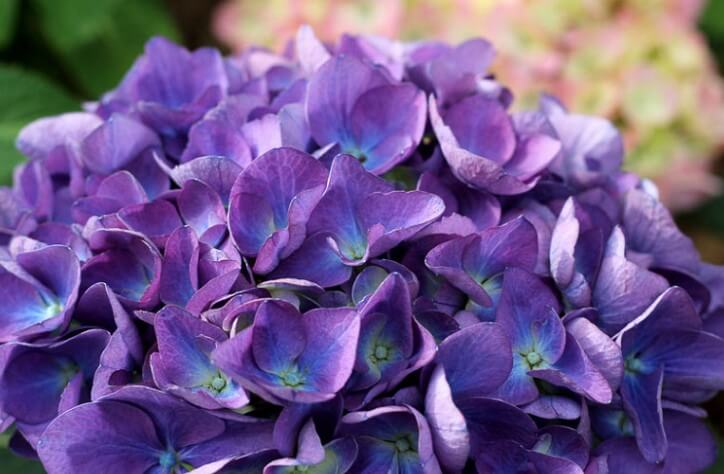
Hydrangea macrophylla ‘Cityline Rio’ is a spectacular hydrangea that can grow in full sun. However, this hydrangea thrives best when planted in alkaline soil to display its beautiful blue or pink blooms.
Regardless of the primary color of the blooms blooming at any given time, this variety’s center petals are accented with a shade of blue or green.
This hardy and resilient flower is a great option for those looking to add color to their landscape without spending too much time maintaining it.
2. Hydrangea Paniculata (Panicle Hydrangea)
Hydrangea paniculata, also known as panicle hydrangea, is a fast-growing shrub that is native to Japan. It has been planted in the United States for many years and is one of the most popular types of hydrangeas available today.
Panicle hydrangeas have large clusters of flowers that grow on vines. They can be pink, blue, or white, with each flower having five petals and being about one inch in diameter.
The clusters of flowers produced at the end of long stems reach up to 6 feet in length. The leaves are green and elliptical in shape, with serrated edges on their ends.
These plants prefer full sun but will also tolerate partial shade if they are watered regularly during dry spells or planted near other plants that will help them retain moisture longer than they would on their own.
They should be planted in soil that drains quickly so that water does not become trapped around their roots and cause root rot problems later on down the road when you may least expect it.
The plants can be grown indoors or outdoors, but they do need plenty of room to grow, and if they are grown outdoors, they will require a lot of maintenance.
They must be kept watered at all times and fed regularly with a good quality fertilizer as well.
Listed below are varieties of panicle hydrangeas for the sun:
6. Hydrangea Paniculata ‘Bobo’
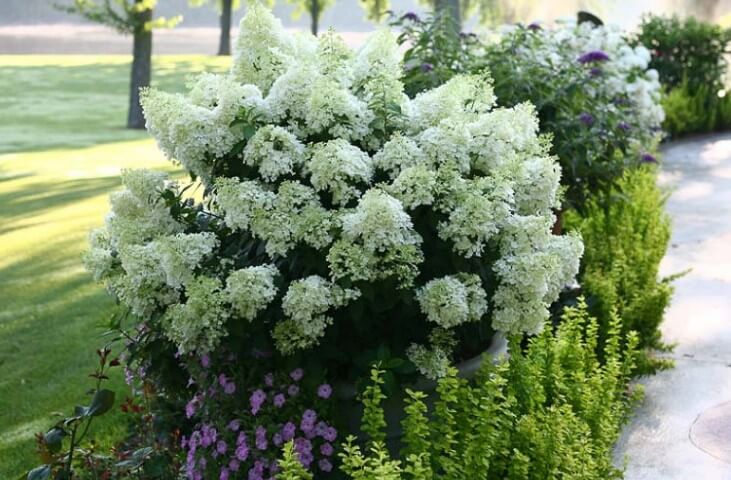
This hydrangea is a Dwarf panicle hydrangea—three feet tall and covered in large, white blooms that turn antique pink as they age.
It flowers from early summer to fall, though some varieties can bloom the first year after planting if conditions are favorable.
Because of its compact, upright habit, this plant can be used in containers or planted as a border around another larger plant.
Hydrangeas grown in cold, winter climates will grow more slowly than those accustomed to warmer temperatures.
However, this plant can still reach full height within two years if planted outside during the right season.
7. Hydrangea Paniculata ‘Candelabra’

The shape of the flowers on “Candelabra” are like flames, and the plant changes color as it matures.
Its red stems contrast beautifully against its green leaves, making this an eye-catching container for winter interest once the leaves have fallen off.
A six-foot shrub that blooms in midsummer and lasts through fall, this plant grows best in USDA zones 3–9. Its white flowers turn red as they mature—a boon for pollinators
8. Hydrangea Paniculata ‘Candy Apple’

‘Candy Apple’ is a small, attractive plant. It grows to only about five feet tall and has flowers that bloom white in the summer. As they age, the flowers turn pink before finally becoming red as autumn approaches.
The dark green leaves make an amazing backdrop for those spectacular blooms! Planted as a specimen in formal gardens or used as a hedge, this upright shrub could grace any garden.
Cold tolerant and hardy through USDA zones 4-8, ‘Candy Apple’ is sure to please even the most discerning gardener!
9. Hydrangea Paniculata ‘Grandiflora’ or Pee Gee Hydrangea

These hydrangeas can be grown as shrubs or trees, depending on which variety you choose. Whichever form is right for your garden will have large blooms that are blush-colored and long-lasting throughout the summer.
If you keep the length of these plants’ shoots to no more than five or ten inches, their flowers will grow up to 12-18 inches long.
These hardy plants can reach heights of 15 feet, making them a great addition—whether it’s as an accent piece in your landscaping or simply filling in empty spaces until something else grows there!
10. Hydrangea Paniculata ‘Limelight’
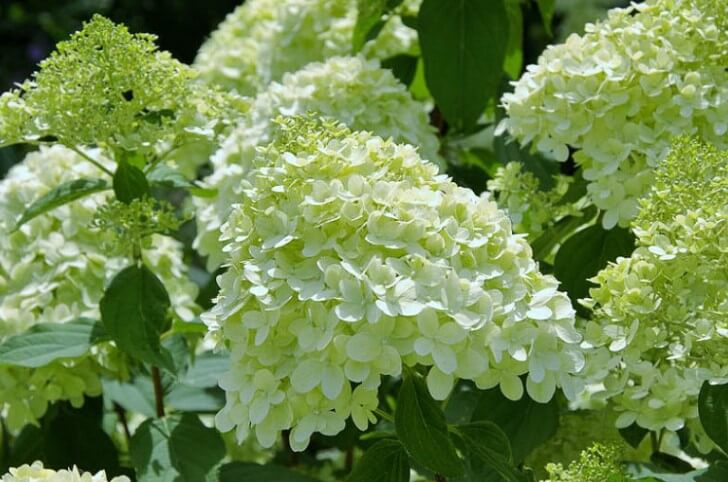
This plant grows to six to eight feet high and wide: its large flowers open as fresh green, aging into pink, red, or burgundy. They last through the frost, making them a good choice for summer-long hedges and privacy screens.
When used in arrangements, these brilliant summer flowers are gorgeous. Limelight hydrangea can brighten up any garden or border planting; it pairs well with other hardy perennials and is extremely cold and heat and humidity-tolerant (USDA Zones 3–9).
11. Hydrangea Paniculata ‘Little lamb’
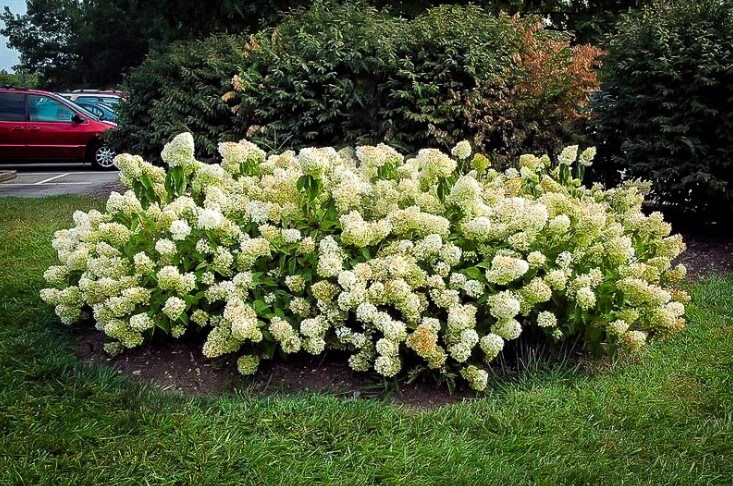
The flower petals of the hydrangea “Little Lamb” are the smallest and most delicate species, making it a unique plant.
Each blossom contains many tiny flowers held tightly together to make it look like a lamb jumping over leaves on this shrub.
Little Lamb will bloom a whitish pink in the middle of summer and may turn light red as fall approaches.
Its four-to-six-foot height and wide spread make it an excellent choice for cutting flowers, mass plantings or adding color throughout your perennial garden.
12. Hydrangea Paniculata ‘Little lime’

The dwarf variety of limelight, known as ‘Little lime’, is only three to five feet tall. However, its fresh green flowers turn pink in fall just like its bigger cousin—and strong stems keep the little blooms upright all season long.
So while it may not be tall enough to form a solid privacy screen, you can use the shrubby blooms of this reliable bloomer as part of an informal hedge.
Prune them in early spring to encourage new flower buds and keep your madras strong throughout zone 10.
13. Hydrangea Paniculata ‘Moon Dance’

This hydrangea has really pretty white cone-shaped flowers growing on top of strong stems with dark green leaves.
As this variety blooms from summer through fall, it maintains its white color throughout the growing season—and is called Moon Dance for that reason!
Moon dance hydrangea is a vigorous vine known for its green foliage. The plant grows between six and eight feet tall, with leaves that measure up to four inches across.
It will also flower just about any time of year if it gets enough morning sun; you can use this as an addition to your garden or let the flowers be their own showpiece by putting them in vases throughout your home.
“Moon dance” does well in hot weather and high humidity, so feel free to plant some wherever there’s space available.
14. Hydrangea Paniculata ‘Pinky Winky’

The large flowers of ‘Pinky Winky’ open as white in mid-late summer, and their base turns pink as the season progresses.
The panicles will continue to bloom—producing pretty white tips on top of each flower—as the season goes on.
‘Pinky Winky’ is a fast-growing, upright evergreen shrub that can be grown in large containers as well as hedges.
It has thick branches that are strong enough to support their own weight without bending over under the pressure of winter snow and ice—making it an excellent choice for colder climates like zone 3-9, where temperatures don’t rise above 80 degrees Fahrenheit during summer months.
15. Hydrangea Paniculata ‘Quick Fire’
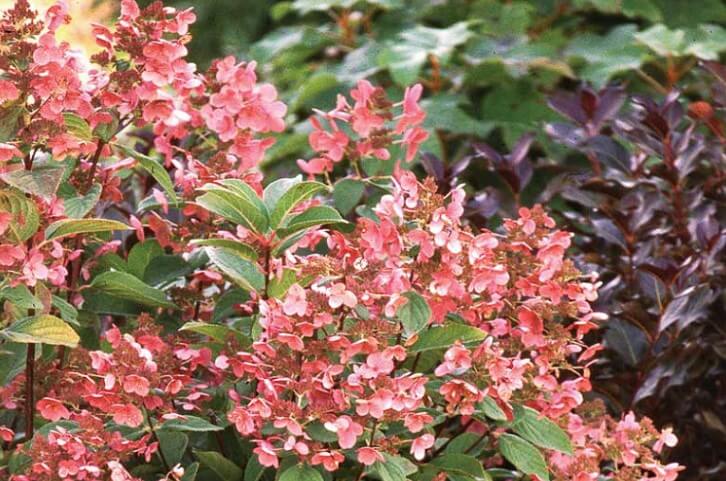
Quick-fire has brilliant fall foliage with gold and burgundy tones. In early July, its lacecap flowers are pure white, but they will continue to darken—to deep reds—by the time of year’s end.
Although quick fire grows six to eight feet tall, there is a dwarf variety called “Little Quick Fire.” A reliable bloomer even after an unkind winter.
16. Hydrangea Paniculata ‘Strawberry Shake’

‘Strawberry Shake’ is a fast-growing variety, reaching four to five feet tall. Flowers start white and mature into pink blooms that give this plant its name—it looks just like a classic strawberry milkshake!
This plant is ideal for containers or to fill in the spaces between larger plants. Cut the flowers before they dry—they make nice arrangements!
17. Hydrangea Paniculata ‘Sweet Summer’
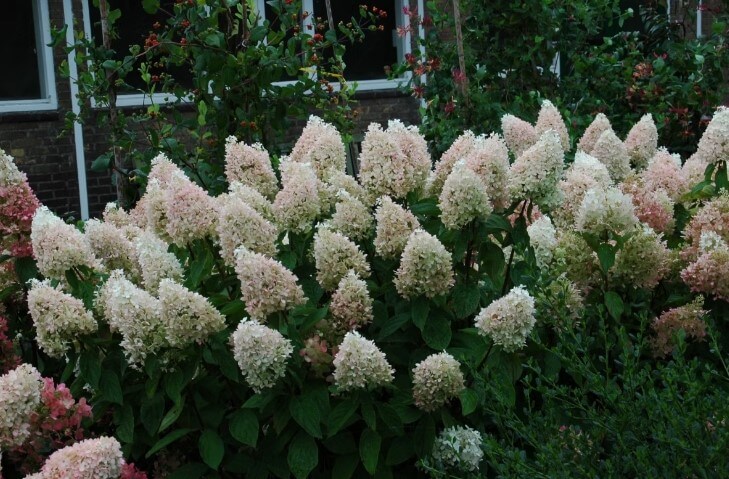
White flowers cover this midsize hydrangea throughout much of the summer. As it gets cooler, however, these will turn pink and fall off—making way for new blooms to come in spring.
This is a quick-growing shrub that will get up to 5’ tall and make an excellent addition to your garden!
18. Hydrangea Paniculata ‘Vanilla Strawberry’
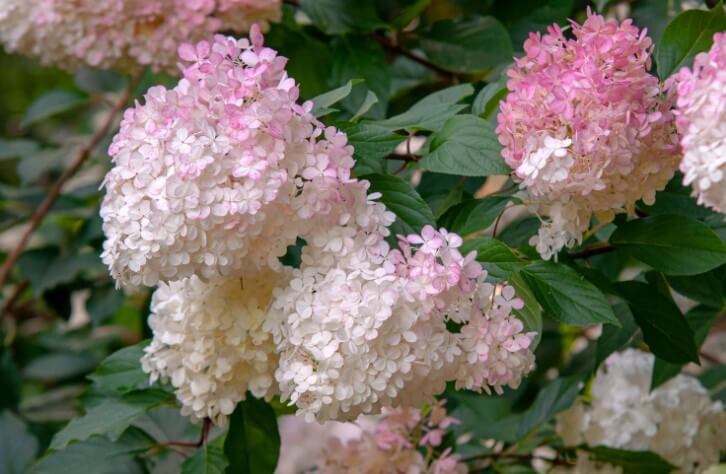
These flowers begin creamy and turn pink, then red. Since new flower heads keep opening on the panicle all season long, plants may simultaneously display all three color stages: cream/pink, pink, and red. ‘Vanilla Strawberry’ flowers from mid-summer through the fall.
Once its blooms have passed, you will be left with red stems to enjoy throughout winter. It grows about 6–7 feet tall and wide, making it a substantial plant for your garden!
19. Hydrangea Paniculata ‘White Wedding’

‘White Wedding’ is covered in abundant, fluffy white flowers on a background of deep green leaves. The plant grows four to six feet high and three to five feet wide—a refreshing addition to any garden! Its blooming period starts in early spring, lasting into the fall season as well.
The plant is very easy to grow, making it a great choice for both beginner and experienced gardeners alike. It grows well in full sun or partial shade, so you can choose where to place it.
Hydrangea Paniculata ‘White Wedding’ is a hardy plant that can withstand most conditions; however, it does require consistent water during its first year of establishment.
20. Hydrangea Paniculata ‘Zinfin Doll’

It starts off with pure white blooms that gradually fade to pink at its base and maintain this rosy color throughout the season.
In addition, they’re similar in appearance to Pinky Winky but are more mophead-shaped than panicles.
Blossoms will appear early spring through late fall, giving you great garden interest for months on end!
This is a great choice for areas that are in part shade or full sun, but it does need consistent water and soil drainage.
It’s also a good choice for those looking for plants that attract butterflies to their garden!
3. Hydrangea Quercifolia (Oakleaf Hydrangea)
Hydrangea quercifolia, also known as Oakleaf Hydrangea, is a type of hydrangea that thrives in full sun.
It has large leaves and clusters of flowers that are white with blue-violet veins. The flowers are very fragrant and bloom in late summer or early fall.
Oakleaf Hydrangea is also known as Oak-Leaf Hydrangea, Quercifolia Hydrangea, and Mountain Laurel.
It is a deciduous shrub that grows to be about 6 feet tall and wide. It makes an excellent addition to any garden because it is drought-tolerant and deer resistant.
This plant has large glossy green leaves that are deeply lobed into three parts with rounded tips. They grow on top of stems which can grow up to 2 feet long.
The flowers appear from June through September and have five oblong white petals with pinkish-purple veins running throughout them. The center of the flower is yellowish-green with many stamens sticking out from within it.
Cuttings or seeds can propagate this plant. It grows best in full sun and partial shade. The soil should be well drained and kept moist but not soggy.
21. Hydrangea Quercifolia ‘Gatsby Gal’

‘Gatsby Gal’ is a beautiful sun-loving hydrangea, growing from five to six feet high and wide. Due to its more compact nature than other oakleaf hydrangeas, this shrub will not spread as much.
The plant’s white panicle blossoms give off a strong scent in the early summer, and those flowers will turn pink as they age.
The oakleaf hydrangea is especially striking in the fall when its leaves turn red before falling from the plant. The shedding of these leaves is also a beautiful part of this plant’s life cycle.
If you are looking to grow oakleaf hydrangeas held in tight containers, this variety is a good choice. It is smaller than other hydrangeas for sunny gardens or flower beds.
22. Hydrangea Quercifolia ‘Snow Queen’

Hydrangea quercifolia ‘Snow Queen’ is a large-flowered variety with white clusters held within the dark green oak leaf shape.
The midsummer blooms develop rosy pink hues in fall as leaves turn deep red bronze, and exfoliating tan-brown bark during winter adds interest to this garden favorite.
It is a deciduous shrub with large, white flowers that blossom in the summer months.
The plant grows up to 8 feet tall, with a spread of 3–4 feet; it prefers well-drained soil and should be watered regularly during this period (late April through September).
23. Hydrangea Quercifolia ‘Snow Flake’

Hydrangea Quercifolia ‘Snow Flake’ is a beautiful variety of hydrangea that does well in full sun. With its double white flowers, this variety is known for its large pyramidal flower panicles.
It typically grows 5-8′ tall and as wide. It blooms in June, fading to pink and then brown by late summer. During autumn, its distinctive leaves change color from dark green to maroon and purple.
4. Hydrangea Serrata (Mountain Hydrangea)
Hydrangea Serrata is a type of hydrangea that is known as the mountain hydrangea. It is native to Japan, where it grows wild in the mountains.
The flowers are very large and showy, with a wide variety of colors. They are also long-lasting when cut and used in floral arrangements.
This flowering shrub has been grown in North America for many years and is one of the most popular varieties of hydrangea. Cultivated in many different color forms, including white, pink, red, and purple.
The blooms on this plant can be up to 3 feet across. The leaves are large and glossy green in color with serrated edges that give them an appearance similar to oak leaves.
The stems are thick and woody as well as long-lasting when cut for use indoors or outdoors during the summer months when they are at their best!
Hydrangea Serrata needs full sun exposure to produce good size flowers, so if you’re thinking of planting some hydrangeas near a window or patio door where there will be plenty of sunshine throughout the day for maximum growth potential!
24. Hydrangea Serrata ‘Tiny Tuff Stuff’
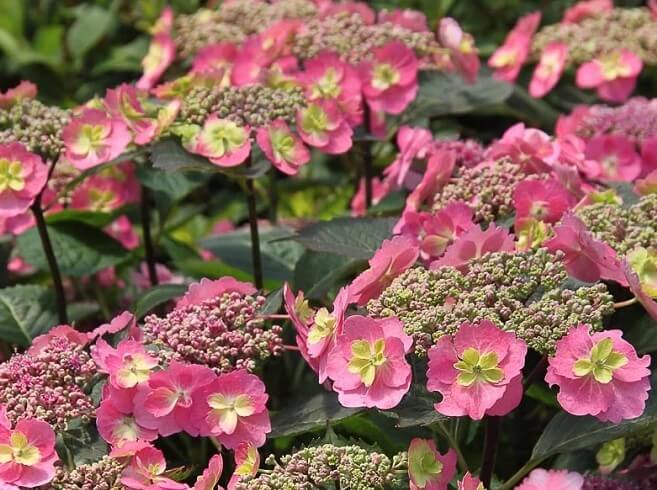
‘Tiny Tuff Stuff’ is a compact flowering shrub that grows from 18 inches to two feet tall. Its leaves are small and narrow, and it blooms profusely throughout the summer with dainty flowers in lots of colors: blue (though some varieties have pink or white petals too).
Adding aluminum sulfate to the soil will encourage these flowers to bloom in a more vibrant blue. When you prune your hydrangea, be careful not to cut into any old or new wood, it will still flower from both growths.
With its low-growing form, this shrub requires little pruning. In fact, you should only remove broken branches or ones that are interfering with other plants.
This mountain hydrangea is hardy in zones 5-9 and can tolerate winter conditions better than most varieties of the species.
Basic Hydrangea Care
How to grow hydrangeas in full sun? This is a common question many beginner gardeners ask when it comes to hydrangea care.
Hydrangeas are one of the most well-known flowering shrubs. They are simple to grow and found in various colors and sizes. Hydrangeas are excellent for full sun or half shade.
In order to get the best performance from your hydrangea plants, you need to understand how to care for them properly. Here are some basic tips:
Pruning
Pruned hydrangeas will produce more blooms than those that haven’t. Therefore, pruning should be done every year in the late summer or the early fall before new growth begins.
Cut back dead foliage, but leave any blooms on the plant if they’re still in good condition and healthy looking.
If you want more flowers next year, cut off buds that form after this year’s bloom season is over (usually late summer).
When pruning, use sharp shears or pruning shears so that you don’t injure yourself or damage the plant when cutting off dead woody stems or removing blossoms from their stems.
Sunlight
Most types of hydrangeas like full sun exposure during the day with some partial shade during midday hours when temperatures rise above 90 degrees Fahrenheit (32 degrees Celsius) during summer months where temperatures regularly exceed 80 degrees Fahrenheit (27 degrees Celsius).
In cooler climates, these types of hydrangeas can tolerate an afternoon sun or partial shade in full sun.
If you want to grow the plant indoors, you can place it near a bright window that receives at least six hours of direct sunlight per day.
Watering
Hydrangeas will require regular watering throughout their growing season (spring through fall) and less often during the winter months.
It’s important to water the plant when the soil has dried out, but not so much that it is soggy.
You can tell if your hydrangea needs more water by looking at the top of its soil; if it is still moist and dark green, then you don’t need to water yet.
If you see that the leaves are drooping, then this is a sign that your hydrangea needs more water.
You can also test whether it needs watering by inserting a bamboo skewer into the soil; if there is no moisture on the end of it after several minutes, then you should consider watering.
Frequently Asked Questions (FAQ)
Q. What is the Most Sun-Tolerant Hydrangea?
A. Panicle hydrangeas, with their large clusters of white flowers that last for weeks and fade from white to pink or red before drying beige, are ideally suited to full sun.
Q. What Hydrangeas Grow in the Sun?
A. One species of hydrangea, the panicle hydrangea, is capable of tolerating the full sun. Most varieties prefer morning light but can thrive in anything from part shade to intense brightness.
Q. Can Hydrangeas Handle Full Sun?
A. Hydrangeas tend to do best with morning sun, but placing them in direct or hot afternoon sunlight is not suitable for them. Later parts of the day’s partial shade are ideal for these plants.
Conclusion
We hope that this guide has been helpful in helping you to choose the best hydrangea for your garden. Hydrangeas are beautiful plants that can add a lot of color and interest to your garden, and they’re relatively easy to take care of as long as you keep them well-watered during the summer months.
